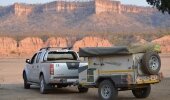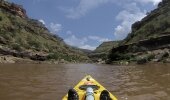Words: Ivan Newmark | Photos: various photographers
I recently returned from a windsurfing trip to Pozo Izquierdo, in Gran Canaria, and believe me when I tell that you haven’t seen windsurfers fly until you have been to this world-famous spot!
Pozo is a very small and laid-back town, where the majority of the locals are either fishermen or radical windsurfers. The Pozo Izquierdo zone is the top spot for windsurfing, any time of the year, and where the very best riders meet up. The trade winds and sea currents in the eastern zone of Gran Canaria have made this beach the centre of world championships year after year, and this is also where you will find the Pozo Izquierdo International Windsurfing Centre, where you can learn and practise this sport at all levels. Even though the weather is fantastic and water warm, a wetsuit is recommended for impact protection! And if the wind gets too much for you, just rent a cheap car and take a 15-minute drive to the south of the island and you’ll find loads of tourists, sandy beaches, full-on parties and no wind.
From the moment I arrived in Pozo Izquierdos’s parking area, I knew it was on! The wind was typical for this site, boasting two to three metre waves and sailors using mainly 3.7 m² sails! The level of sailors that congregate at this windsurfing Mecca is crazy … they do perfect back loops, push loops, double forwards and push forwards, all the time. Their endless repertoire of moves is seriously impressive to watch and it makes you want to elevate your own level of jumping. But what struck me most was the good, friendly vibe between everyone on and off the water.
At this beach it’s very important to sail with your weight on your harness, otherwise your hands get destroyed. I started sailing with 34-inch lines to help control down-the-line and overpowered sailing. I took two sails and one 72l board, and used my 4.5 m2 only five times and the 3.7 m2 every other day, all day. Pozo is the perfect spot for practising those high jump loops, and if you can land them here, you can land them anywhere!
After four days of non-stop sailing my hands were starting to take strain. Luckily I was saved by a hot weather condition called Kalima. This is when a heat wave and dust from the Sahara comes in and hangs over the islands for a few days, and temperatures rise to 35 degrees in the day and 28 degrees at night, with no air movement, and surfing in the north is the only option. After Kalima the wind returned and was stronger than ever, with sailing 3.7 m² overpowered every day. The only way you could control the wind was to sail at 8 a.m.
I had planned my trip to coincide with the Professional Windsurfing Association (PWA) World Cup, which is held at Pozo, and everyone who is anyone, including all the guys from the windsurfing movies, was there. Just watching Phillip Koster and Victor Vernandez training for this event, and crazy Ricardo Campello doing his 12 m stalled double forward, was enough to blow my mind! The event was amazing, with the sailors giving it their all and showing no mercy in gusts of up to 61 knots on the one day. The action and crashes were out of this world. Guys like Kauli Seadi needed a 3.2 m², and I still remember when Phillip went for a massive push to forward in the finals and had his sail ripped out of his hand because of wind gusts six metres up in the air. After five days of sitting and watching the best live action possible, it was time for the guys to move on to the next event in Tenerife. I was quite relieved as this meant that this spot wouldn’t be as crowded.
During the six weeks I was in Pozo, there was only about five days when the wind was simply too strong to sail. In these conditions everyone meets at El Viento Restaurant to enjoy a Bocadillio (a 6- to 8-inch long portion of baguette that is sliced in half and filled with Spanish chorizo sausage, cold cuts, tuna or Serrano ham) and watch a few die-hards surfing with 3.0 m² sails. But for the true fanatic, there are a few other spots to go to that have less wind, like Vargas and Salinas.
After sailing at Pozo my fear of jumping high was a thing of the past. Now there is just one thing left to do and that is push the level of the local sailors in South Africa, because we also have the best variety of conditions, the most perfect wind and an awesome social life!
My thanks to Brian from Suntrax / Cape Dr. for supporting me on this trip with the 3.7 m² Ezzy Wave Panther Sail and Ezzy Mast. This gear once again proved itself as I didn’t have any breakages! And to my parents for sponsoring and making this trip possible! Now it’s payback time!
See you on the water.
Steven Rhodes from Windsurfing Africa (www.windsurfingafrica.org) caught up with Ivan to find out more about his thoughts on Pozo and this high-adrenaline sport.
1. It sounds like Pozo is a great learning ground for really big air. Is it more about big wind and waves, or are you just trying to copy the pros?
It is actually about both. Pozo is a really small, constricted windsurfing spot, with rocks all around you. This forces you to sail really close to all the pros and while they are jumping over your head, you always keep an eye on them, absorbing all those images and subconsciously you are training the visual side of the moves. This gives you the confidence to try them.
2. What’s the biggest move you pulled and didn’t make?
The biggest move I tried was the double forward loop.
After a few attempts I smashed myself nicely. Haha.
3. Does SA have anything similar to Pozo, and what has this trip done for your confidence?
SA has the same wild conditions, if not better! The wind at Cape Point gets as strong as it does at Pozo, and it’s windy almost every day during the summer. We are also fortunate enough to have multiple windsurf spots and can move to the next beach when it gets to strong at your beach. Pozo has done a lot for my confidence, especially for going high and controlling moves.
4. The last couple of seasons has seen a renewed interest in twin, thrusters, and quad-fin boards. Do you think it makes any difference to getting big air?
No. When getting big air the original single fin boards jump just as high as the latest boards on the market.
5. What’s all the hype with the 4-batten sails?
Was anyone using them in Pozo?
I’ve heard so many people give their opinion on the new, 2013 4-batten sails. The current top two wave sailors in the world are using 4-batten sails at Pozo, so I guess they work. At the end of the day it is just a marketing ploy, so the pros have to use them.
6. What’s your top windsurfing travel tip?
Pay some guy to carry all your equipment!
7. Your dreadlocks were so cool. Were they slowing you down or is UCT turning you into a banker?
Haha! Yes they were slowing down my brain capacity (according to my parents) and speeding up my windsurfing crashes! Each day in class I ask myself if I am still a surfer or have I completely turned into full-time banker. But honestly, getting a degree is really important and I count myself very lucky J.
8. You’re the hardest charger I’ve seen under 30. Do you see yourself competing on the PWA?
That was my idea before I went to Pozo and witnessed my first PWA event. I just don’t know if it is really worth sitting on some overcrowded beach waiting for your heat, stressing, being competitive with your mates, and worrying about competition money. There will be so much more joy in your life if you go to some quiet spot with your best mates and just sail the most perfect waves all day - and still be a super good sailor.
9. Your trip prior to Pozo was Fuerteventura, so what’s next on the list?
If my bank account allows it, I definitely want to go to Reunion Island in June/July 2013. All local South African sailors must join me, so you guys better start scaling down on those sundowner beers and start saving up!
10. What is your recommendation on getting to Pozo and where to stay, if you are on a budget?
I found the cheapest way to travel to Pozo was to fly to Madrid via Dubai (Emirates takes gear at no extra costs) and then on to Gran Canaria. I stayed in an apartment, a cheaper alternative, which was within walking distance of the beach, so renting a car was not needed and helped save on costs.




